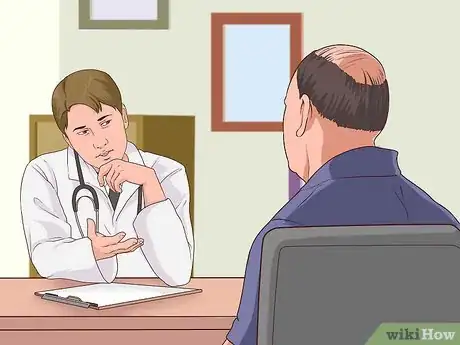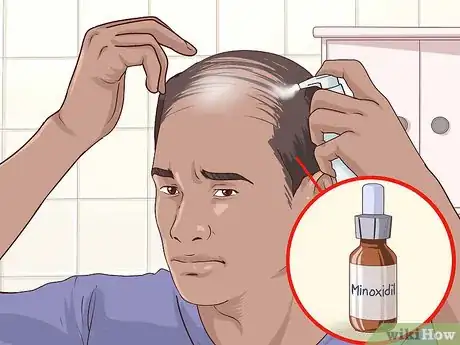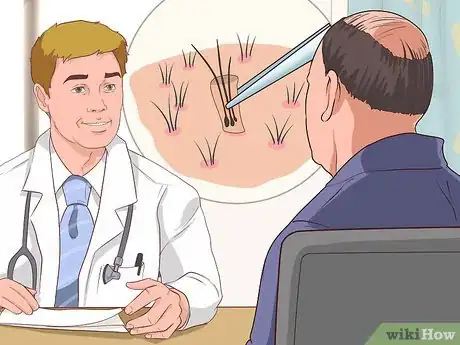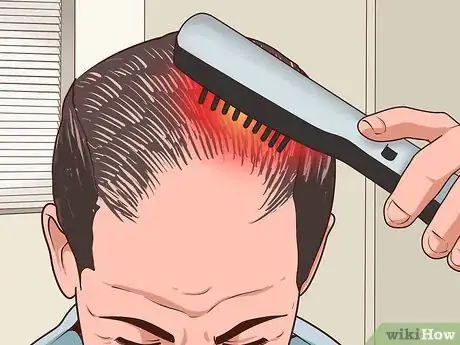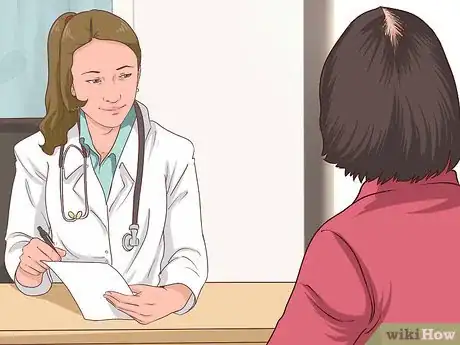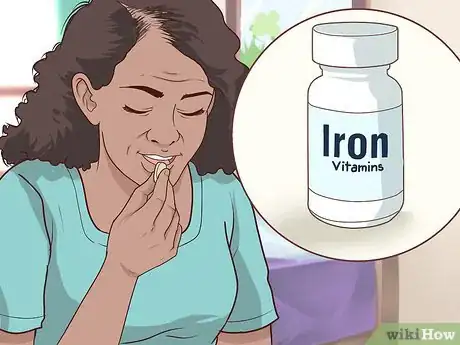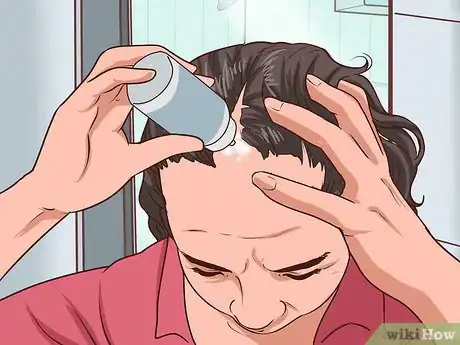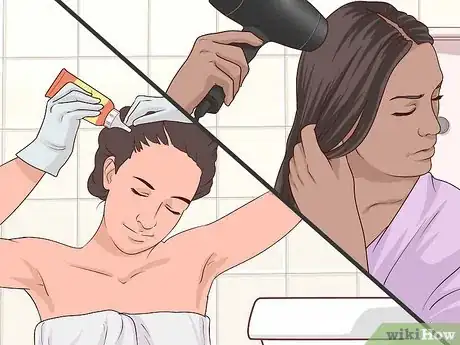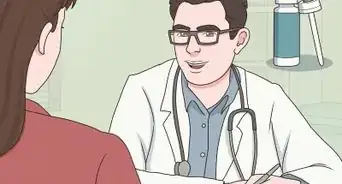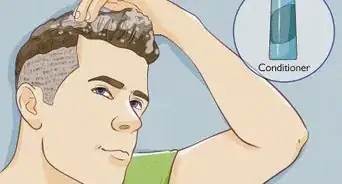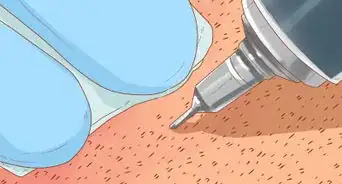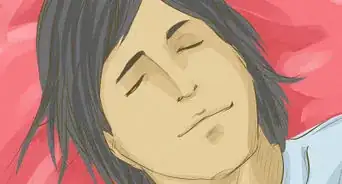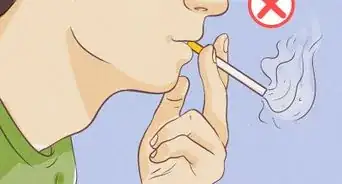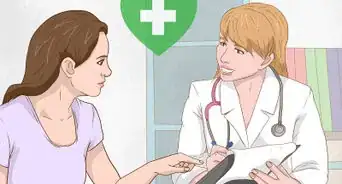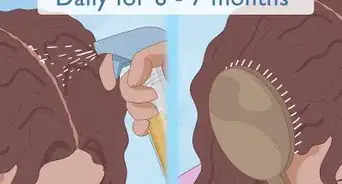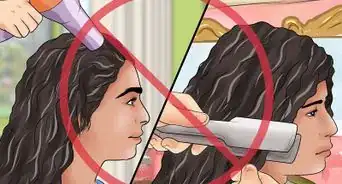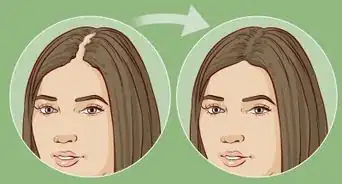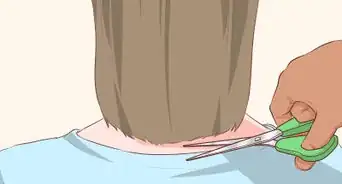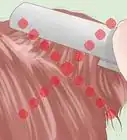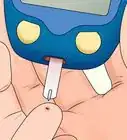This article was co-authored by David Nazarian, MD. Dr. David Nazarian is a board certified Internal Medicine Physician and the Owner of My Concierge MD, a medical practice in Beverly Hills California, specializing in concierge medicine, executive health and integrative medicine. Dr. Nazarian specializes in comprehensive physical examinations, IV Vitamin therapies, hormone replacement therapy, weight loss, platelet rich plasma therapies. He has over 16 years of medical training and facilitation and is a Diplomate of the American Board of Internal Medicine. He completed his B.S. in Psychology and Biology from the University of California, Los Angeles, his M.D. from the Sackler School of Medicine, and a residency at Huntington Memorial Hospital, an affiliate of the University of Southern California.
There are 10 references cited in this article, which can be found at the bottom of the page.
This article has been viewed 65,485 times.
Hair loss can be frustrating for men and women alike. While the internet is full of supposed miracle cures for hair loss—ranging from herbal pills to applying onion juice to one’s scalp—the truth is that none of these methods have ever proven successful in a scientific trial.[1] While the miracle cures don’t work, there are still a variety of scientifically-proven and FDA-approved options for regrowing hair.
Steps
Treating Hair Loss in Men
-
1Consult a doctor. Reasons for hair loss in the first place can vary. The classic issue of male pattern baldness is due to a testosterone derivative called dihydrotestosterone and the effect it has on hair follicles.[2] Baldness due to a condition called alopecia areata comes from the body’s own immune system attacking hair follicles.[3] In order to treat any specific case and potentially regrow hair, a doctor will first need to determine the cause of the hair loss.
- Your doctor will likely run a panel to test for any severe vitamin deficiencies that could be responsible as well. For instance, a severe zinc deficiency[4] or vitamin D deficiency[5] can lead to hair loss; however, you should still consult a doctor to determine the true cause of your hair loss before self-diagnosing and beginning an over-the-counter vitamin regimen.
-
2Discuss oral treatment solutions. Once your doctor has run a few tests to discover the source of your hair loss, the treatment option may be as simple as an over-the-counter or prescription pill that can stop the hair loss and in many cases regrow hair.
- If you doctor suspects that the hair loss was due to a vitamin deficiency such as zinc, then a zinc supplement can often reverse the process and lead to regrowth of normal hair quantities.[6]
- If you have a folic acid deficiency, you can have trouble growing your hair, thus the doctor can recommend a folic acid supplement like biotin at 5000 micrograms a day to help with hair growth.
- If your doctor determines that dihydrotestosterone (DHT) is to blame for the hair loss, then he or she may prescribe finasteride, which is known more commonly as Propecia or one of its generics.[7] Finasteride is one of the most commonly prescribed medicines in cases of hair loss because it lowers DHT levels in a way that stops hair loss and often achieves a level of regrowth. Side effects of Propecia include depression, sexual dysfunction & prostate cancer.[8]
- If your doctor determines that your hair loss is due to the autoimmune disease alopecia areata—which is only about 1% of the population[9] —then recent findings have shown a class of drugs called JAK inhibitors are effective in regrowing hair.[10] These drugs stop hair loss and promote hair regrowth by suppressing the body’s immune response to the afflicted hair follicles. The arthritis drug Ruxolitinib has shown some of the most-positive results.[11]
Advertisement -
3Discuss topical treatment solutions. In addition to oral medications, your doctor may discuss topical medications. The most common topical suggestion is minoxidil (Rogaine and its generics).[12] Minoxidil is another option for DHT-related hair loss, and it most commonly requires application to the scalp twice a day.[13]
- When applied in early stages of hair loss, minoxidil can not only stop hair loss but often stimulate regrowth.[14]
- One of the drawbacks to minoxidil is that it requires strict adherence to the application regimen. When a man stops taking minoxidil, he will lose the regrown hair as a consequence.[15]
-
4Discuss surgical treatments. Hair transplant technology has come a long way, and your doctor may discuss this option with you as a permanent solution that doesn’t require daily medication. Your doctor can test to find areas of the scalp that are not affected by DHT, and small sections of these hair follicles can be grafted to the affected area of the scalp.[16]
- Despite offering a permanent solution, transplant surgery is the most expensive option, often requiring several procedures to build a full look over time.[17]
- Hair transplants are also the most common method suggested for regrowing hair in those with bald patches due to burns or other injuries that damaged original hair follicles.
-
5Discuss laser combs. Only the third nonsurgical hair loss method to receive FDA approval, laser combs are hand-held devices that stimulate hair follicles with low-level lasers.[18] Laser combs are still in their infancy and many dermatologists are wary of their ability to permanently regrow hair since they don’t affect DHT levels; however, early trials did increase hair growth in many participants.[19]
Treating Hair Loss in Women
-
1Consult a doctor. As with hair loss in men, the most important first step is to consult a doctor. The earlier a woman seeks care, the sooner a doctor can administer the proper treatment, which is more likely to yield positive results and regrowth.[20]
- Your doctor will run a panel of tests to check everything from deficiencies to levels of dihydrotestosterone (DHT).
-
2Discuss oral treatment solutions. Deficiencies such as zinc[21] , iron[22] , or vitamin D[23] can result in hair loss. After your doctor runs a panel of tests, he or she may recommend a stronger daily dose of deficient vitamins or minerals.
- In cases where hormonal abnormalities are present—specifically the presence of excess male hormones known as androgens—medications such as spironolactone (which limits aldosterone production) or oral contraceptives may be the solution.[24]
- In cases where the diagnosis is alopecia areata, early data shows that JAK inhibitors such as ruxolitinib can suppress the immune response causing the hair loss.[25]
-
3Discuss topical treatments. A doctor may decide to prescribe minoxidil (Rogaine and its generics) for a woman with DHT-related hair loss. Whereas the minoxidil formulation for men is typically 5%, women are more commonly prescribed a 2% formula.[26]
- For a women who really want to maximize the potential for hair regrowth, a doctor may still prescribe the stronger 5% solution; however, while very effective, this can lead to increased facial hair growth as a side effect.[27]
- As with men, one of the major drawbacks of minoxidil for women is that the product requires strict adherence to its application. Regrown hair will quickly recede with discontinued use.
-
4Discuss hair transplant options. Hair transplant surgeries relocate healthy hair follicles to affected areas of the scalp and are very effective methods of regrowing hair. Transplant options are best for women with traction alopecia (caused by long wear of tight braids or other things that pull the hair) or hair loss due to trauma such as scarring or burns.[28]
- Unfortunately, most women with DHT-related hair loss see a general thinning across the entire scalp as opposed to male pattern baldness which typically affects very specific areas.[29] This means that finding a donor site of unaffected follicles is more difficult; however, it isn’t impossible.[30]
- As with men, transplant options for women are effective but quite expensive.
-
5Do not worry about refraining from typical hair care regimens. If a doctor has diagnosed the problem as DHT-related hair loss, then you do not need to worry about altering daily hair care of styling options as nothing is structurally wrong with the hair—the issue is stemming from the hair follicles. You can continue to dye and style hair as normal.[31]
Expert Q&A
-
QuestionHow can hair be regenerated?
 David Nazarian, MDDr. David Nazarian is a board certified Internal Medicine Physician and the Owner of My Concierge MD, a medical practice in Beverly Hills California, specializing in concierge medicine, executive health and integrative medicine. Dr. Nazarian specializes in comprehensive physical examinations, IV Vitamin therapies, hormone replacement therapy, weight loss, platelet rich plasma therapies. He has over 16 years of medical training and facilitation and is a Diplomate of the American Board of Internal Medicine. He completed his B.S. in Psychology and Biology from the University of California, Los Angeles, his M.D. from the Sackler School of Medicine, and a residency at Huntington Memorial Hospital, an affiliate of the University of Southern California.
David Nazarian, MDDr. David Nazarian is a board certified Internal Medicine Physician and the Owner of My Concierge MD, a medical practice in Beverly Hills California, specializing in concierge medicine, executive health and integrative medicine. Dr. Nazarian specializes in comprehensive physical examinations, IV Vitamin therapies, hormone replacement therapy, weight loss, platelet rich plasma therapies. He has over 16 years of medical training and facilitation and is a Diplomate of the American Board of Internal Medicine. He completed his B.S. in Psychology and Biology from the University of California, Los Angeles, his M.D. from the Sackler School of Medicine, and a residency at Huntington Memorial Hospital, an affiliate of the University of Southern California.
Board Certified Internal Medicine Physician Ask your doctor about platelet-rich plasma injections for hair loss! This treatment involves taking platelet-rich plasma and injecting it into the scalp. This causes neovascularization, which is new blood flow to the hair and scalp. Additionally, the cytokines and growth factors that are in platelet-rich plasma help stimulate the hair follicles that are in limbo.
Ask your doctor about platelet-rich plasma injections for hair loss! This treatment involves taking platelet-rich plasma and injecting it into the scalp. This causes neovascularization, which is new blood flow to the hair and scalp. Additionally, the cytokines and growth factors that are in platelet-rich plasma help stimulate the hair follicles that are in limbo.
Warnings
- While some doctors may prescribe a version of finasteride (Propecia and generics) to women, the drug can lead to serious developmental issues for male fetuses. Therefore the drug should be avoided for any women who are pregnant or who are considering becoming pregnant.[32]⧼thumbs_response⧽
- Thus far the use of laser combs is only approved in men.[33]⧼thumbs_response⧽
Expert Interview

Thanks for reading our article! If you'd like to learn more about growth of hair, check out our in-depth interview with David Nazarian, MD.
References
- ↑ http://www.webmd.com/men/features/men-and-hair-loss-what-are-the-options?page=3
- ↑ http://www.webmd.com/skin-problems-and-treatments/hair-loss/hair-loss-causes-men
- ↑ http://www.nytimes.com/2014/08/18/health/alopecia-patients-in-study-grow-hair-with-new-drug.html?_r=0
- ↑ http://www.ncbi.nlm.nih.gov/pubmed/17618180/
- ↑ http://www.ncbi.nlm.nih.gov/pmc/articles/PMC2835491/
- ↑ http://www.ncbi.nlm.nih.gov/pubmed/17618180/
- ↑ http://www.webmd.com/men/features/men-and-hair-loss-what-are-the-options
- ↑ http://www.webmd.com/men/features/men-and-hair-loss-what-are-the-options
- ↑ http://www.nytimes.com/2014/08/18/health/alopecia-patients-in-study-grow-hair-with-new-drug.html?_r=0
- ↑ http://www.nytimes.com/2014/08/18/health/alopecia-patients-in-study-grow-hair-with-new-drug.html?_r=0
- ↑ http://www.nytimes.com/2014/08/18/health/alopecia-patients-in-study-grow-hair-with-new-drug.html?_r=0
- ↑ http://www.webmd.com/men/features/men-and-hair-loss-what-are-the-options?page=2
- ↑ http://www.webmd.com/men/features/men-and-hair-loss-what-are-the-options?page=2
- ↑ http://www.webmd.com/men/features/men-and-hair-loss-what-are-the-options?page=2
- ↑ http://www.webmd.com/men/features/men-and-hair-loss-what-are-the-options?page=2
- ↑ http://www.webmd.com/men/features/men-and-hair-loss-what-are-the-options?page=2
- ↑ http://www.webmd.com/men/features/men-and-hair-loss-what-are-the-options?page=2
- ↑ http://www.webmd.com/men/features/men-and-hair-loss-what-are-the-options?page=3
- ↑ http://www.webmd.com/men/features/men-and-hair-loss-what-are-the-options?page=3
- ↑ http://www.webmd.com/skin-problems-and-treatments/hair-loss/features/fighting-hair-loss-in-women
- ↑ http://www.ncbi.nlm.nih.gov/pubmed/17618180/
- ↑ http://www.webmd.com/skin-problems-and-treatments/hair-loss/features/fighting-hair-loss-in-women?page=2
- ↑ http://www.ncbi.nlm.nih.gov/pmc/articles/PMC2835491/
- ↑ http://www.webmd.com/skin-problems-and-treatments/hair-loss/features/fighting-hair-loss-in-women?page=2
- ↑ http://www.nytimes.com/2014/08/18/health/alopecia-patients-in-study-grow-hair-with-new-drug.html?_r=0
- ↑ http://www.webmd.com/skin-problems-and-treatments/hair-loss/features/fighting-hair-loss-in-women
- ↑ http://www.webmd.com/skin-problems-and-treatments/hair-loss/features/fighting-hair-loss-in-women
- ↑ http://www.webmd.com/skin-problems-and-treatments/hair-loss/women-hair-restoration
- ↑ http://www.webmd.com/skin-problems-and-treatments/hair-loss/women-hair-restoration
- ↑ http://www.webmd.com/skin-problems-and-treatments/hair-loss/women-hair-restoration
- ↑ http://www.webmd.com/skin-problems-and-treatments/hair-loss/features/fighting-hair-loss-in-women?page=2
- ↑ http://www.webmd.com/skin-problems-and-treatments/hair-loss/features/fighting-hair-loss-in-women?page=2
- ↑ http://www.webmd.com/skin-problems-and-treatments/hair-loss/features/fighting-hair-loss-in-women?page=2
About This Article
To regrow hair, start by making an appointment with your doctor so they can determine the true cause of your hair loss. Your doctor may recommend treatments such as taking a zinc supplement, which can reverse the hair loss process and allow hair to grow back. Alternatively, take iron or vitamin D supplements in pill form, since deficiencies in these vitamins can cause hair loss, especially in women. The doctor might also suggest applying a topical treatment such as Minoxidil twice a day, which can stimulate regrowth. For tips on how to regrow hair with a laser comb, read on!
